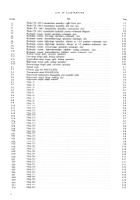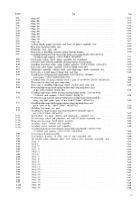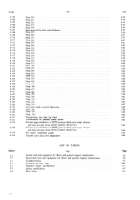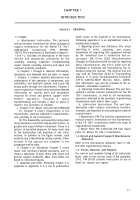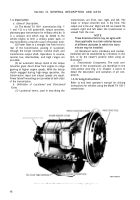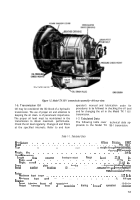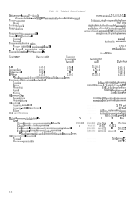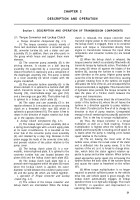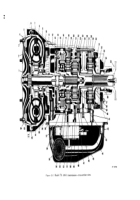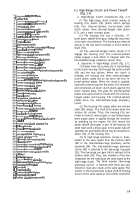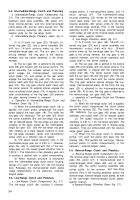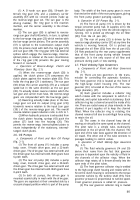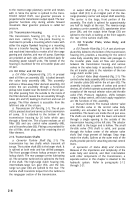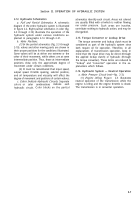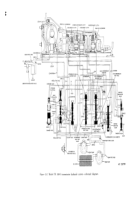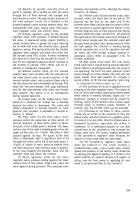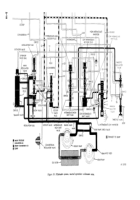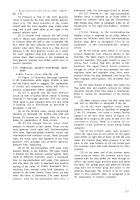TM-9-2520-254-34 - Page 13 of 126
2-3. Intermediate-Range Clutch and Planetary
a. Intermediate-Range Clutch Components (fig.
2-1).
The intermediate-range clutch includes a
stationary back plate assembly (18), piston (21),
three internal-splined,
and two external-tanged
clutch plates (19), and ten return springs (51). The
piston housing assembly (22) serves also as a
reaction plate for the low-range clutch.
b. Intermediate-Range Planetary Gears
(fig. 2-
1).
(1) A 31-tooth sun gear (53), 59-tooth (in-
ternal) ring gear (20), and a carrier assembly (54)
with four 14-tooth pinions make up the in-
termediate-range gear set. The sun gear is the
driving
member,
the ring gear
is the reaction
member, and the carrier assembly is the driven
member.
(2) The sun gear (53) is splined to the turbine
shaft (59) and meshes with the carrier pinions. The
carrier assembly (54) includes splines at the front
which
engage
the
internal-splined,
high-range
clutch plates (17), and splines at the rear which
engage the low-range ring gear (23). The carrier
pinions mesh with both the sun gear (53) and ring
gear (20). The ring gear internal teeth mesh with
the carrier pinions. Its external splines engage the
intern al-splined clutch plates (19). A retainer at the
outer circumference of the ring gear (20) prevents
the gear moving forward or rearward.
c. Operation of Intermediate-Range Clutch and
Planetary Gears
(fig. 2-1).
(1) When the intermediate-range clutch (19) is
applied. the clutch piston compresses the clutch
plates against the back plate (18). This holds the
ring gear (20) stationary. The sun gear (53) drives
the carrier assembly (54) and low-range ring gear
(23) at reduced speed. The low-range sun gear (46)
(rotating at the same speed as the intermediate-
range sun gear (53)
and the low-range ring gear
(23) (rotating at a lower speed) combine to drive
the low-range planetary carrier and transmission
output shaft at a different rate of speed.
(2) The actual speed reduction ratio in the
intermediate-range gear set is 2.90 to 1. However,
when this ratio is combined with that of the low-
range gear set. the overall speed reduction ratio is
1.93 to 1. The interaction of two planetary gear sets
to produce a desired ratio is called compounding.
(3) When hydraulic pressure is exhausted
from the intermediate-range clutch piston housing,
springs (51) return the piston (21) into the housing
bore. Released, the internal-splined clutch plates
rotate independently of the stationary, external-
tanged plates.
2-4. Low-Range Clutch and Planetary
a. Low-Range Clutch Components
(fig. 2-1).
The low-range clutch (24) includes 3 external-
tanged plates, 3 internal-splined plates, and 12
return
springs (47).
The intermediate-range
housing assembly (22) serves as the low-range
clutch back plate. The low- and reverse-range
housing assembly (26) serves jointly for the low-
and reverse-range clutches. Pins in the housing
assembly anchor the low-range, external-tanged
clutch plates, as well as the reverse-range, external-
tanged plates, against rotation.
b. Low-Range Planetary Gears
(fig. 2-1).
(1) A 21-tooth sun gear (46), 59-tooth (in-
ternal) ring gear (23), and a carrier assembly and
transmission
output shaft with four
19-tooth
pinions make up the low-range gear set. The sun
gear is the driving member, the ring gear is the
reaction member, and the carrier assembly and
output shaft is the driven member.
(2) The sun gear (46) is splined to the turbine
shaft (59) and meshes with the carrier pinions. The
carrier assembly is integral with the transmission
output shaft (33). The carrier pinions mesh with
both the sun gear (46) and ring gear (23). The ring
gear internal teeth mesh with the carrier pinions.
The ring gear external splines engage the low-
range, internal-splined plates. At the front, the ring
gear (23) is attached to the intermediate-range
carrier (54). At its rear, the ring gear is attached to
the reverse-range sun gear shaft (40).
c. operation of Low-Range Clutch and Planetary
Gears
(fig. 2-1).
(1) When the low-range clutch (24) is applied,
the clutch piston compresses the clutch plates
against the housing (22). This holds the ring gear
(23) stationary
+
The sun gear (46) drives carrier
assembly and output shaft (33) at reduced speed.
(2) The speed reduction in the low-range
planetary is 3.81 to 1 for low-range operation. The
low-range gears have another role in reverse-range
operation. They are compounded with the reverse-
range gears (para 2-5).
(3) When the low-range clutch is released.
springs
(47) push the piston (25) back into the
housing (26). This permits the low-range, internal-
splined plates to rotate independently of the
stationary . external-tanged plates.
2-5. Reverse-Range Clutch and Planetary
a. Reverse-Range Clutch Components
(fig. 2-1).
The reverse-range clutch includes a stationary back
plate (30), piston (27). 4 internal-splined and 3
external-tanged clutch plates (28), and 12 return
springs
(43).
The piston housing assembly (26)
serves jointly
for the reverse-
and low-range
clutches. Pins in the housing assembly anchor the
reverse-range, external-tanged clutch plates, as well
as the low-range, external-tanged clutch plates,
against rotation.
b.
Reverse-Range
Planetary Gears
(fig. 2-1).
2-4
Back to Top

